

Therefore the same IOR value is a good approximation for both reflection and refraction. IOR can also be used to measure reflection and how light reflects off a surface relative to the viewing angle (Yourself) and although calculated in a slightly different way they are usually directly proportional. Place a stick in a pool of water, notice how the stick bends below the water surface? As light passes through the water surface it changes speed and bends. IOR stands for index of refraction and is used to measure how light refracts through a surface relative to the viewing angle (Yourself), confusing at first but read on. Fresnel studied the behaviour of light and how it was transmitted and spread by different objects. The Fresnel Effect was first documented by the French physicist Augustin-Jean Fresnel (1788-1827). Fresnel is a good approximation and is as close to physically correct materials as you can get whilst keeping the rendering times low. If you position yourself to the side of the monitor and look into the glass you will clearly see a reflection of the environment, but if you position yourself directly in front you will notice that the reflection is reduced. A good example of this would be to look at an old CRT monitor, where the viewing panel is glass. Most materials except metals have a Fresnel reflection, making the reflection strong at glancing angles but weak at more front on angles. White reflects the entire visible colour spectrum whereas black absorbs all colour. Polished marble (Depending on colour), 30 - 70 %ĭiffuse colour also affects the reflection intensity.However the following can be used as a guide.īy default the reflection colour acts as a filter for the diffuse colour and the stronger the reflection colour the dimmer the diffuse colour. You would commonly use a grey scale value to determine the reflection strength and there is no right or wrong value so you will have to take your best judgement. By using colour instead of grey scale you will get coloured reflections. White RGB (255,255,255) is fully reflective and black RGB (0,0,0) is not reflective at all. Like diffuse it uses a colour value to determine the reflection strength. The light rays are bouncing all over the place, and not being absorbed.Ĭan be used to simulate dust on a surface by controlling the way the surface reflects direct light. If you render an object that is pure white or pure black you will notice that there is no contrast.

When creating a white or black material, set the colour values to an off white RGB (245,245,245) / black RGB (2,2,2). It is important to understand that no material in the real world is pure white RGB (25,255,255) nor pure black RGB (0,0,0). This is the actual colour of the surface, reflection and refraction colours can affect the visual appearance of this colour. Each material is brought back into the 3ds Max environment so you can see how the results look when applied directly to the model.A more in depth look at each setting within a Vray material for version Vray 2.0.
#CONCRETE MATERIAL VRAY 3DS MAX HOW TO#
He also shows how to use the standalone and 3ds Max node-based versions of B2M to convert existing bitmaps into materials. He shows how to create custom materials-including wood, concrete, metal, and stucco-using V-Ray and Substance Designer. Here George explains how to import the SketchUp drawing into 3ds Max and UV map the geometry so you can texture and enhance the design. The training continues George Maestri's residential modeling series, which started in SketchUp with a concept drawing for a single family home. This course helps you build custom materials for texturing the exterior of residential buildings with 3ds Max 2019, Substance Designer, V-Ray, and Bitmap2Material (B2M). Physically accurate materials add impact to any design. Anyone who presents architectural renderings and visualizations to clients knows the importance of realistic materials.


 0 kommentar(er)
0 kommentar(er)
